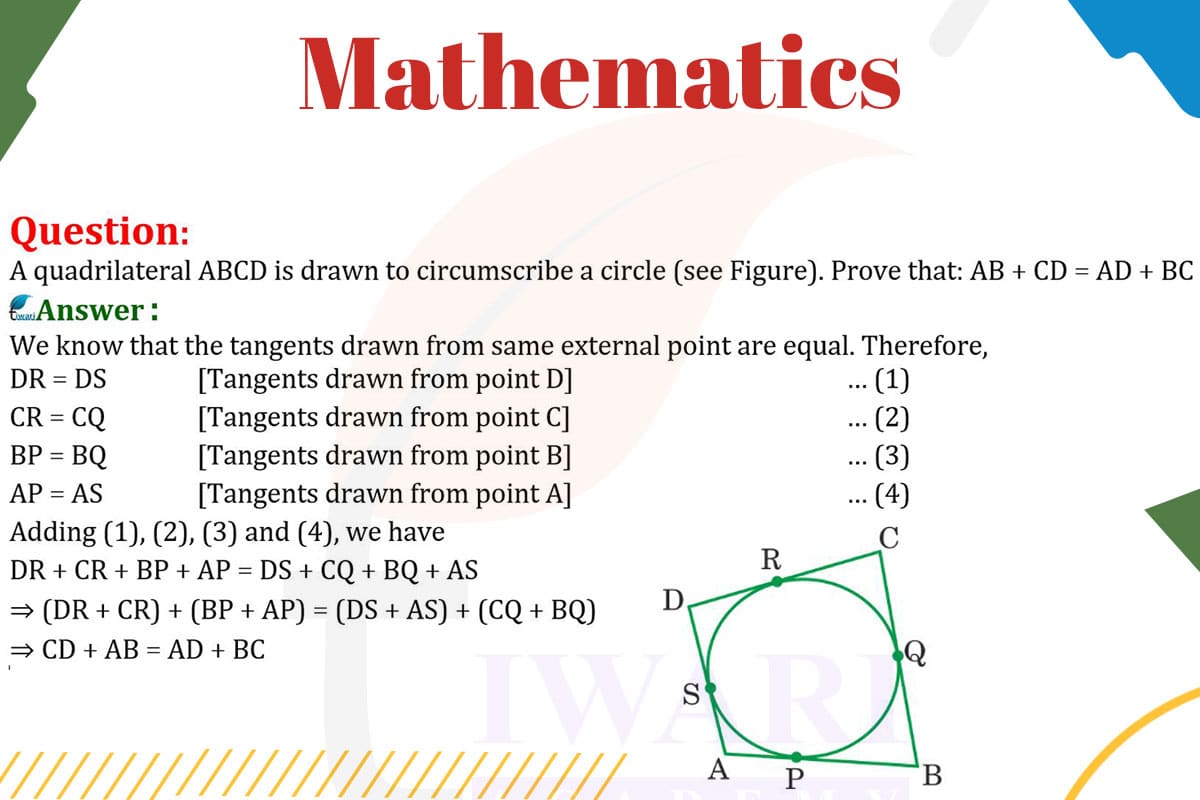To prove that in a quadrilateral ABCD, which circumscribes a circle, AB + CD = AD + BC:
Tangency Points: Let the points where the circle touches the quadrilateral be P, Q, R, and S, starting from the side AB and moving clockwise.
Equal Tangents: From each vertex, the tangents to a point of contact with the circle are equal in length. Therefore, AP = AS, BQ = BP, CR = CQ, and DS = DR.
Sum of Sides: AB = AP + BP, BC = BQ + CQ, CD = CR + DR, AD = AS + DS.
Substituting Equal Lengths: Substitute the equal tangents into the sum of sides: AB = AS + BP, BC = BP + CR, CD = CR + DR, AD = AS + DR.
Adding Equal Sides: Add AB and CD, and AD and BC separately: AB + CD = (AS + BP) + (CR + DR), AD + BC = (AS + DR) + (BP + CR).
Result: Since the sums are equal, AB + CD = AD + BC.
Thus, in a quadrilateral circumscribing a circle, the sum of the lengths of one pair of opposite sides is equal to the sum of the lengths of the other pair of opposite sides.

Let’s discuss in detail
Introduction to Circumscribed Quadrilaterals
In the study of geometry, a fascinating concept is that of a quadrilateral circumscribing a circle. This occurs when a circle fits perfectly inside a quadrilateral, touching all four sides. An intriguing property of such a configuration is that the sum of the lengths of one pair of opposite sides of the quadrilateral is equal to the sum of the lengths of the other pair of opposite sides. This property is not immediately apparent and requires a deeper understanding of the properties of tangents and circumscribed figures.
Understanding Tangents in Circumscribed Figures
A key aspect of circumscribed figures is the role of tangents. In a quadrilateral ABCD circumscribing a circle, each side of the quadrilateral acts as a tangent to the circle at a specific point. Tangents from a common external point to a circle are equal in length. This property of tangents is crucial for proving the relationship between the sides of the quadrilateral.
Identifying Tangency Points
Consider the quadrilateral ABCD with the circle touching its sides at points P, Q, R, and S. These points are located on sides AB, BC, CD, and DA, respectively. The tangency points create segments on the sides of the quadrilateral, which are essential in our proof. For instance, AP and AS are segments on side AD, created by the tangency point S.
Applying the Property of Tangents
According to the property of tangents, the lengths of tangents drawn from an external point to a circle are equal. Therefore, in our quadrilateral, AP = AS, BQ = BP, CR = CQ, and DS = DR. These equalities are fundamental to establishing the relationship between the sides of the quadrilateral.
Summing the Sides of the Quadrilateral
To utilize these equalities, we express each side of the quadrilateral in terms of the segments formed by the tangency points. For example, side AB can be expressed as AP + PB, and side AD as AS + SD. Doing this for all sides and substituting the equal lengths, we find that the sum of the lengths of AB and CD is equal to the sum of the lengths of AD and BC.
Proving the Quadrilateral Property
By adding the lengths of opposite sides and using the property of tangents, we conclude that AB + CD = AD + BC in the circumscribed quadrilateral ABCD. This elegant result showcases the harmony and interconnectedness of geometric principles. It highlights how properties of tangents and circumscribed figures come together to reveal surprising and non-intuitive truths about geometric shapes.
Discuss this question in detail or visit to Class 10 Maths Chapter 10 for all questions.
Questions of 10th Maths Exercise 10.2 in Detail

